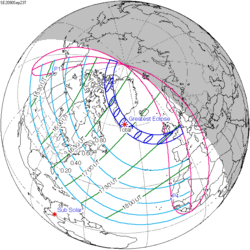| Annular eclipse | |
| Gamma | −0.0426 |
|---|---|
| Magnitude | 0.9878 |
| Maximum eclipse | |
| Duration | 86 s (1 min 26 s) |
| Coordinates | 19°24′N123°42′W / 19.4°N 123.7°W |
| Max. width of band | 43 km (27 mi) |
| Times (UTC) | |
| Greatest eclipse | 20:21:59 |
| References | |
| Saros | 137 (38 of 70) |
| Catalog # (SE5000) | 9633 |
An annular solar eclipse will occur at the Moon's ascending node of orbit on Wednesday, July 12, 2056, [1] with a magnitude of 0.9878. A solar eclipse occurs when the Moon passes between Earth and the Sun, thereby totally or partly obscuring the image of the Sun for a viewer on Earth. An annular solar eclipse occurs when the Moon's apparent diameter is smaller than the Sun's, blocking most of the Sun's light and causing the Sun to look like an annulus (ring). An annular eclipse appears as a partial eclipse over a region of the Earth thousands of kilometres wide. Occurring about 5.8 days after apogee (on July 7, 2056, at 1:55 UTC), the Moon's apparent diameter will be smaller. [2]
Contents
- Eclipse details
- Eclipse season
- Related eclipses
- Eclipses in 2056
- Metonic
- Tzolkinex
- Half-Saros
- Tritos
- Solar Saros 137
- Inex
- Triad
- Solar eclipses of 2054–2058
- Saros 137
- Metonic series
- Tritos series
- Inex series
- References
- External links
The path of annularity will be visible from parts of Kiribati, northern Ecuador, southern Colombia, extreme northern Peru, and western Brazil. A partial solar eclipse will also be visible for parts of eastern Oceania, Hawaii, the United States, Mexico, Central America, the Caribbean, and western South America290.








































































































